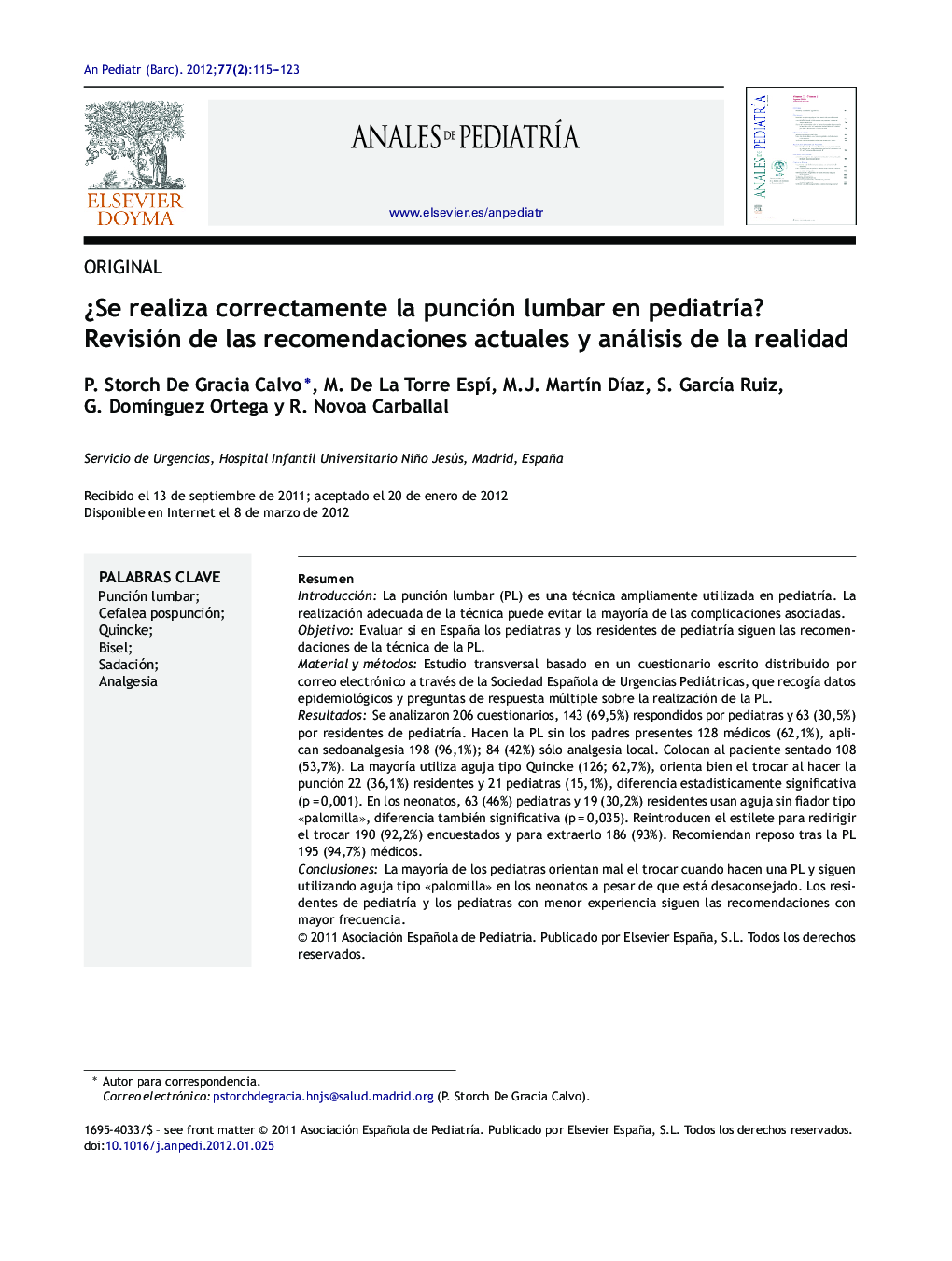| کد مقاله | کد نشریه | سال انتشار | مقاله انگلیسی | نسخه تمام متن |
|---|---|---|---|---|
| 4142140 | 1272359 | 2012 | 9 صفحه PDF | دانلود رایگان |

ResumenIntroducciónLa punción lumbar (PL) es una técnica ampliamente utilizada en pediatría. La realización adecuada de la técnica puede evitar la mayoría de las complicaciones asociadas.ObjetivoEvaluar si en España los pediatras y los residentes de pediatría siguen las recomendaciones de la técnica de la PL.Material y métodosEstudio transversal basado en un cuestionario escrito distribuido por correo electrónico a través de la Sociedad Española de Urgencias Pediátricas, que recogía datos epidemiológicos y preguntas de respuesta múltiple sobre la realización de la PL.ResultadosSe analizaron 206 cuestionarios, 143 (69,5%) respondidos por pediatras y 63 (30,5%) por residentes de pediatría. Hacen la PL sin los padres presentes 128 médicos (62,1%), aplican sedoanalgesia 198 (96,1%); 84 (42%) sólo analgesia local. Colocan al paciente sentado 108 (53,7%). La mayoría utiliza aguja tipo Quincke (126; 62,7%), orienta bien el trocar al hacer la punción 22 (36,1%) residentes y 21 pediatras (15,1%), diferencia estadísticamente significativa (p = 0,001). En los neonatos, 63 (46%) pediatras y 19 (30,2%) residentes usan aguja sin fiador tipo «palomilla», diferencia también significativa (p = 0,035). Reintroducen el estilete para redirigir el trocar 190 (92,2%) encuestados y para extraerlo 186 (93%). Recomiendan reposo tras la PL 195 (94,7%) médicos.ConclusionesLa mayoría de los pediatras orientan mal el trocar cuando hacen una PL y siguen utilizando aguja tipo «palomilla» en los neonatos a pesar de que está desaconsejado. Los residentes de pediatría y los pediatras con menor experiencia siguen las recomendaciones con mayor frecuencia.
IntroductionLumbar puncture (LP) is a commonly performed procedure in paediatrics. Performing this technique properly can avoid the most common associated complications.ObjectiveTo assess whether paediatricians and paediatric residents in Spain follow current recommendations for the LP technique.Material and methodsA cross-sectional study was conducted by sending a questionnaire by mail through the Spanish Society of Paediatric Emergencies, collecting demographic information and responses to multiple choice questions about LP technique.ResultsA total of 206 questionnaires were analysed, of which 143 (69.5%) were answered by paediatricians, and 63 (30.5%) by paediatric residents. The majority (128; 62.1%) of physicians did not allow parents to be present during LP, 198 (96.1%) routinely use analgesia and sedation; 84 (42%) only used local anaesthesia. The majority of respondents used standard Quincke needles (126; 62.7%). The bevel was correctly positioned when puncturing the dura mater by 22 residents (36.1%) and 21 paediatricians (15.1%), a variation that was statistically significant (P=.001). For neonatal lumbar punctures, 63 paediatricians (46%) and 19 paediatric residents used a butterfly needle which did not contain a stylet, and this difference was also statistically significant (P=.035). Of those surveyed, 190 (92.2%) re-inserted the stylet when re-orientating the needle, and 186 (93%) re-oriented this when removing it. The recommendation of bed rest was made by 195 (94.7%) physicians.ConclusionsThe majority of paediatricians orient the bevel wrongly when inserting the needle during LP, and still use “butterfly” needles in newborns, despite warnings to the contrary. Paediatric residents and less experienced paediatricians follow the recommendations more frequently.
Journal: Anales de Pediatría - Volume 77, Issue 2, August 2012, Pages 115–123